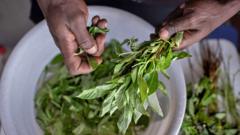The bustling Skinners Restaurant in Gachie, near Nairobi, showcases a culinary revival as indigenous leafy vegetables, once considered "poor man's food," gain notoriety among diners. With dishes featuring "kienyeji" greens such as managu (African nightshade) and mrenda (jute mallow), customers increasingly prefer local varieties over mainstream options like cabbage and spinach.
Kimani Ng’ang’a, a restaurant employee, highlights a surge in demand for these traditional crops, which boast richer nutrient profiles compared to their colonial counterparts, the sukumawiki—the Swahili term meaning "to stretch the week." The change reflects a growing trend among Kenyans who value organic produce.
Horticulture professor Mary Abukutsa-Onyango notes a significant shift over the past decade, with local greens’ production doubling to 300,000 tonnes last year. Studies support their nutritional superiority, revealing they contain higher vitamins, minerals, and antioxidants.
Despite their former reputation as weeds, indigenous vegetables are increasingly recognized for their health benefits and resilience to diseases. The United Nations educational agency, UNESCO, acknowledged Kenya’s efforts to safeguard these cultural heritages by recording 850 indigenous plants, leading to a brighter future for diverse diets.
With sukumawiki remaining the staple for many Kenyan farmers—over 700,000 tonnes harvested in 2023—Francis Ngiri advocates for organic farming of indigenous crops, practicing sustainability with 124 native varieties on his Rift Valley farm. Collaborations with 800 local farmers promote seed exchanges, critical to preserving genetic diversity against government regulations limiting uncertified seed exchange.
Despite the regulatory environment, vendors like Priscilla Njeri report that indigenous greens have eclipsed traditional options in popularity. The rise of local culinary markets demonstrates an essential shift in perception and consciousness around Kenya’s rich agricultural heritage, providing hope for its future resilience. As campaigns to promote these nutritious greens gain traction, the evolving landscape illustrates the powerful connection between food, health, and culture.



















